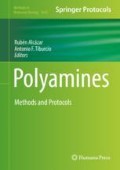Abstract
Polyamines are essential poly-cations with vital functions in all cellular systems. Their levels are controlled by intricate regulatory feedback mechanisms. Abnormally high levels of polyamines have been linked to cancer. A rate-limiting enzyme in the biosynthesis of polyamines in fungi and higher eukaryotes is ornithine-decarboxylase (ODC). Its levels are largely controlled posttranslationally via ubiquitin-independent degradation mediated by ODC antizyme (OAZ). The latter is a critical polyamine sensor in a feedback control mechanism that adjusts cellular polyamine levels. Here, we describe an approach employing quantitative western blot analyses that provides in vivo evidence for cotranslational polyamine-sensing by nascent OAZ in yeast. In addition, we describe an in vitro method to detect polyamine binding by antizyme.
The original version of this chapter was revised. A correction to this chapter can be found at https://doi.org/10.1007/978-1-4939-7398-9_41
Change history
06 September 2018
Correction to: Chapter 26 in: Rubén Alcázar and Antonio F. Tiburcio (eds.), Polyamines: Methods and Protocols, Methods in Molecular Biology, vol. 1694, https://doi.org/10.1007/978-1-4939-7398-9_26
References
Michael AJ (2016) Biosynthesis of polyamines and polyamine-containing molecules. Biochem J 473(15):2315–2329
Tabor CW, Tabor H (1984) Polyamines. Annu Rev Biochem 53:749–790
Thomas T, Thomas TJ (2001) Polyamines in cell growth and cell death: molecular mechanisms and therapeutic applications. Cell Mol Life Sci 58:244–258
Childs AC, Mehta DJ, Gerner EW (2003) Polyamine-dependent gene expression. Cell Mol Life Sci 60:1394–1406
Palanimurugan R, Kurian L, Hegde V, Hofmann K, Dohmen RJ (2014) Co-translational polyamine sensing by nascent ODC Antizyme. In: Ito K (ed) Regulatory nascent polypeptides. Springer, Tokyo, pp 203–222
Nakanishi S, Cleveland JL (2016) Targeting the polyamine-hypusine circuit for the prevention and treatment of cancer. Amino Acids 48:2353–2362
Murray-Stewart TR, Woster PM, Casero RA Jr (2016) Targeting polyamine metabolism for cancer therapy and prevention. Biochem J 473:2937–2953
Liu JH, Wang W, Wu H, Gong X, Moriguchi T (2015) Polyamines function in stress tolerance: from synthesis to regulation. Front Plant Sci 6:827
Tiburcio AF, Altabella T, Bitrian M, Alcazar R (2014) The roles of polyamines during the lifespan of plants: from development to stress. Planta 240:1–18
Coffino P (2001) Regulation of cellular polyamines by antizyme. Nat Rev Mol Cell Biol 2:188–194
Illingworth C, Michael AJ (2012) Plant ornithine decarboxylase is not post-transcriptionally feedback regulated by polyamines but can interact with a cytosolic ribosomal protein S15 polypeptide. Amino Acids 42:519–527
Kahana C (2016) Protein degradation, the main hub in the regulation of cellular polyamines. Biochem J 473:4551–4558
Murakami Y, Matsufuji S, Kameji T, Hayashi S, Igarashi K, Tamura T, Tanaka K, Ichihara A (1992) Ornithine decarboxylase is degraded by the 26S proteasome without ubiquitination. Nature 360:597–599
Palanimurugan R, Scheel H, Hofmann K, Dohmen RJ (2004) Polyamines regulate their synthesis by inducing expression and blocking degradation of ODC antizyme. EMBO J 23:4857–4867
Matsufuji S, Matsufuji T, Miyazaki Y, Murakami Y, Atkins JF, Gesteland RF, Hayashi S (1995) Autoregulatory frameshifting in decoding mammalian ornithine decarboxylase antizyme. Cell 80:51–60
Ivanov IP, Atkins JF (2007) Ribosomal frameshifting in decoding antizyme mRNAs from yeast and protists to humans: close to 300 cases reveal remarkable diversity despite underlying conservation. Nucleic Acids Res 35:1842–1858
Kurian L, Palanimurugan R, Gödderz D, Dohmen RJ (2011) Polyamine sensing by nascent ornithine decarboxylase antizyme stimulates decoding of its mRNA. Nature 477:490–494
Heinemeyer W, Kleinschmidt JA, Saidowsky J, Escher C, Wolf DH (1991) Proteinase yscE, the yeast proteasome/multicatalytic-multifunctional proteinase: mutants unravel its function in stress induced proteolysis and uncover its necessity for cell survival. EMBO J 10:555–562
Gietz RD, Sugino A (1988) New yeast-Escherichia coli shuttle vectors constructed with in vitro mutagenized yeast genes lacking six-base pair restriction sites. Gene 74:527–534
Author information
Authors and Affiliations
Corresponding author
Editor information
Editors and Affiliations
Rights and permissions
Copyright information
© 2018 Springer Science+Business Media LLC
About this protocol
Cite this protocol
Palanimurugan, R., Gödderz, D., Kurian, L., Dohmen, R.J. (2018). Analysis of Cotranslational Polyamine Sensing During Decoding of ODC Antizyme mRNA. In: Alcázar, R., Tiburcio, A. (eds) Polyamines. Methods in Molecular Biology, vol 1694. Humana Press, New York, NY. https://doi.org/10.1007/978-1-4939-7398-9_26
Download citation
DOI: https://doi.org/10.1007/978-1-4939-7398-9_26
Published:
Publisher Name: Humana Press, New York, NY
Print ISBN: 978-1-4939-7397-2
Online ISBN: 978-1-4939-7398-9
eBook Packages: Springer Protocols

